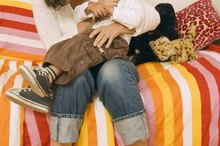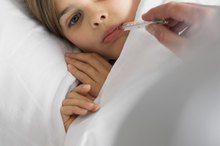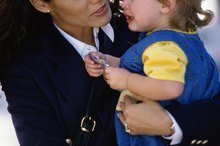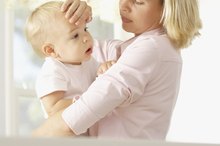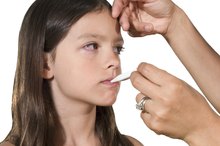High Fever of 103.5 in Children
According to California Pacific Medical Center, most viral fevers range between 101 degrees and 104 degrees and disappear after two or three days 2. A fever of 103.5 degrees Fahrenheit technically sits on the border between a common fever and a high fever. It often requires home treatment, but a doctor's visit may not be necessary unless your child displays other disconcerting symptoms.
Fever Symptoms
KidsHealth explains that fevers occur when the hypothalamus -- the body's internal thermostat -- raises the body's temperature in response to an infection or other internal threat 5. As such, a fever is only a symptom of illness rather than an illness itself, but fevers often cause additional symptoms 4. According to MayoClinic.com, other common symptoms associated with fevers include:
- sweating
- shivering
- headache
- body ache
- loss of appetite
- general weakness 4
A fever of 103.5 may also cause hallucinations, frustration, convulsions and dehydration.
Possible Causes
When Should Children Go to the Hospital for a Fever?
Learn More
Infections cause the majority of fevers. Standard culprits of childhood fevers include sinus infections, ear infections, bronchitis, sore throats and other cold or flu-like illnesses that affect your child's respiratory system. Autoimmune disorders such as Crohn's disease and cancers such as leukemia can also cause fevers of 103.5 degrees or greater.
- Infections cause the majority of fevers.
- Autoimmune disorders such as Crohn's disease and cancers such as leukemia can also cause fevers of 103.5 degrees or greater.
Home Treatment
Home treatment reduces most fevers. New York Presbyterian Hospital states that you should treat any childhood fever equal to or greater than 102.2 degrees Fahrenheit 3. Give your child plenty of fluids to prevent dehydration caused by sweating. Your child may respond best to cold fluids such as ice water and popsicles. Dress your child in lightweight clothes and provide a light blanket, but avoid overdressing. A lukewarm spongebath may also make your child feel more comfortable. Older children may receive fever-reducing acetaminophen or ibuprofen, but always follow the package instructions when administering medication to your child.
- Home treatment reduces most fevers.
- Give your child plenty of fluids to prevent dehydration caused by sweating.
Contacting Your Doctor
A Child That Continuously Awakes From a Nap With a Fever
Learn More
A fever of 103.5 degrees is a serious matter for children under one year in age. According to MedlinePlus, you should contact the doctor if a child under three months has a fever of 100.4 degrees or higher or if a child between three months and one year has a fever of 102.2 degrees or higher. A fever of 103.5 is not of grave concern in older children, but if the fever lasts 48 to 72 hours or climbs to 105 degrees, call your pediatrician. Additionally, if your child refuses fluids, displays signs of dehydration, complains of severe pain or demonstrates lethargy or difficulty waking up, you should call your doctor's office or emergency room.
- A fever of 103.5 degrees is a serious matter for children under one year in age.
- A fever of 103.5 is not of grave concern in older children, but if the fever lasts 48 to 72 hours or climbs to 105 degrees, call your pediatrician.
Related Articles
References
- MedLine Plus: Fever
- California Pacific Medical Center: Caring for Your Child's Fever
- MayoClinic.com: Fever - Symptoms
- KidsHealth: Fever and Taking Your Child's Temperature
- Ask Dr. Sears.com; Fever; William Sears, M.D.
- Gunduz S, Usak E, Koksal T, Canbal M. Why Fever Phobia Is Still Common? Iran Red Crescent Med J. 2016;18(8):e23827. doi:10.5812/ircmj.23827
- American Academy of Pediatrics. Fever and Your Baby. Updated August 3, 2016.
- Torreggiani S, Filocamo G, Esposito S. Recurrent Fever in Children. Int J Mol Sci. 2016;17(4):448. doi:10.3390/ijms17040448
- InformedHealth.org. Fever in Children: Overview. Cologne, Germany: Institute for Quality and Efficiency in Health Care (IQWiG); 2013.
- InformedHealth.org. Fever in children: When to see a doctor. Cologne, Germany: Institute for Quality and Efficiency in Health Care (IQWiG); 2009.
- MedlinePlus. When your baby or infant has a fever. Updated February 13, 2020.
- Lim T. Cleveland Clinic. Kids’ Fevers: When to Worry, When to Relax. Published May 12, 2015.
- Murren-Boezem J. The Nemours Foundation. Fevers. Updated September 2018.
- When your baby or infant has a fever: MedlinePlus Medical Encyclopedia. MedlinePlus. Nov 6, 2019.
- Vaccine Side Effects. Vaccines. Dec 2017.
- Fever in Children: Overview. Cologne, Germany: Institute for Quality and Efficiency in Health Care (IQWiG); 2019.
- Seinfeld S, Shinnar S. Febrile Seizures. Swaimans Pediatric Neurology. 2017:519-523. doi:10.1016/b978-0-323-37101-8.00065-5
- "When Your Baby or Infant Has a Fever". Medical Encyclopedia 04 Dec 13. MedlinePlus. US National Library of Medicine. US Department of Health and Human Services. National Institutes of Health.
- "Fever and Your Baby". Health Issues 20 Aug 15. Caring for Your Baby and Young Child: Birth to Age 5. American Academy of Pediatrics.
Writer Bio
Caitlynn Lowe has been writing since 2006 and has been a contributing writer for Huntington University's "Mnemosyne" and "Huntingtonian." Her writing has also been in "Ictus" and "Struggle Creek: A Novel Story." Lowe earned her Bachelor of Arts degree in English from Huntington University.

